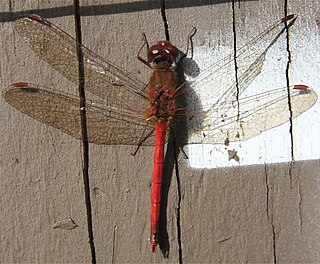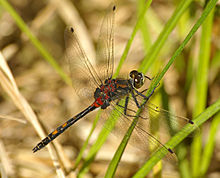
Odonata is an order of predatory flying insects that includes the dragonflies and damselflies. The two groups are distinguished with dragonflies usually being bulkier with large compound eyes together and wings spreaded up or out at rest, while damselflies are usually more slender with eyes placed apart and wings folded together along body at rest. Adult odonates can land, but rarely walk.

Predation is a biological interaction where one organism, the predator, kills and eats another organism, its prey. It is one of a family of common feeding behaviours that includes parasitism and micropredation and parasitoidism. It is distinct from scavenging on dead prey, though many predators also scavenge; it overlaps with herbivory, as seed predators and destructive frugivores are predators.

A dragonfly is a flying insect belonging to the infraorder Anisoptera below the order Odonata. About 3,000 extant species of dragonflies are known. Most are tropical, with fewer species in temperate regions. Loss of wetland habitat threatens dragonfly populations around the world. Adult dragonflies are characterized by a pair of large, multifaceted, compound eyes, two pairs of strong, transparent wings, sometimes with coloured patches, and an elongated body. Many dragonflies have brilliant iridescent or metallic colours produced by structural coloration, making them conspicuous in flight. An adult dragonfly's compound eyes have nearly 24,000 ommatidia each.

Damselflies are flying insects of the suborder Zygoptera in the order Odonata. They are similar to dragonflies but are smaller and have slimmer bodies. Most species fold the wings along the body when at rest, unlike dragonflies which hold the wings flat and away from the body. Damselflies have existed since the Jurassic, and are found on every continent except Antarctica.

Enallagma cyathigerum is a species found mainly between latitudes 40°N and 72°N; It is widely distributed in the Palearctic, and the Nearctic species Enallagma annexum was at one time considered to be synonymous with it. The species can reach a length of 32 to 35 mm. It is common in many different countries including Russia, Sweden, Norway, Finland, the United States of America, and South Korea. Damselflies are an important link between the health of the aquatic ecosystem and its response to climate change.

The Hine's emerald is an endangered dragonfly species found in the United States and Canada. Populations exist in Illinois, Michigan, Missouri, Ontario, and Wisconsin. Larvae are found in shallow, flowing water in fens and marshes, and often use crayfish burrows. Major threats to the species include habitat loss and alteration, and the species is legally protected in both the United States and Canada.

The Cordulegastridae are a family of Odonata (dragonflies) from the suborder Anisoptera. They are commonly known as spiketails. Some vernacular names for the species of this family are biddie and flying adder. They have large, brown or black bodies with yellow markings, and narrow unpatterned wings. Their bright eyes touch at a single point, and they can be found along small, clear, woodland streams, flying slowly 30 to 70 cm above the water. When disturbed, however, they can fly very rapidly. They usually hunt high in forest vegetation, and prefer to capture prey resting on leaves or branches.

Sympetrum pedemontanum, the banded darter, is a dragonfly belonging to the genus Sympetrum. It is characterized by its small stature, dark wing bands, and red or yellow body. It lives in areas with low vegetation and stagnant or weakly flowing bodies of water. Although debate exists regarding the taxa's relationship to others in its genus, it can most commonly be identified by its wing bands, bilobed prothorax, and possibly its genitalia.

The blue dasher is an insect of the skimmer family. It is the only species in the genus Pachydiplax. It is very common and widely distributed through North America and into the Bahamas.

The Pseudostigmatidae are a family of tropical damselflies, known as helicopter damselflies, giant damselflies, or forest giants. The family includes the largest of all damselfly species. They specialize in preying on web-building spiders, and breed in phytotelmata, the small bodies of water held by plants such as bromeliads.

Megaloprepus caerulatus, also known as the blue-winged helicopter, is a forest giant damselfly of the family Coenagrionidae. Forest giant damselflies were previously recognized as their own family, Pseudostigmatidae. M. caerulatus is found in wet and moist forests in Central and South America. It has the greatest wingspan of any living damselfly or dragonfly, up to 19 centimeters (7.5 inches) in the largest males. Its large size and the markings on its wings make it a conspicuous species; a hovering Megaloprepus has been described as a "pulsating blue-and-white beacon".

Sympetrum vicinum, the Yellow-Legged Meadowhawk is one of some fifteen North American species of autumn meadowhawk, which are members of the Odonate family Libellulidae. It grows to 26–35 mm long.

The dot-tailed whiteface is a species of dragonfly in the family Libellulidae. It is also one of the most common and widespread in the genus Leucorrhinia.

The Hudsonian whiteface is a species of dragonfly in the family Libellulidae. Its common name comes from where it is found, Hudson Bay.

Black Lake is a nature reserve in Delamere Forest, Cheshire, England. It lies in the southwestern corner of the forest, just south of the Manchester–Chester railway. It is managed by the Cheshire Wildlife Trust (CWT) on behalf of the Forestry Commission, and as a Site of Special Scientific Interest (SSSI) is monitored by Natural England.

Bradinopyga geminata is a species of dragonfly in the family Libellulidae known commonly as the granite ghost. It is native to India, Sri Lanka and Thailand, where it is a common and widespread species.

Pursuit predation is a form of predation in which predators actively give chase to their prey, either solitarily or as a group. It is an alternate predation strategy to ambush predation — pursuit predators rely on superior speed, endurance and/or teamwork to seize the prey, while ambush predators use concealment, luring, exploiting of surroundings and the element of surprise to capture the prey. While the two patterns of predation are not mutually exclusive, morphological differences in an organism's body plan can create an evolutionary bias favoring either type of predation.

The giant hawker or the gigantic riverhawker, is a species of dragonfly in the family Aeshnidae. It is found throughout Sundaland, having been recorded on Thailand, Peninsular Malaysia, Singapore, Sumatra, and Borneo. It is the type species for the genus Tetracanthagyna.



















